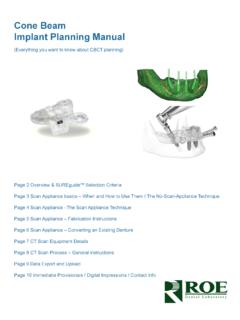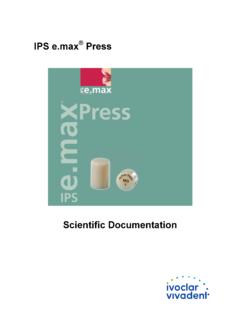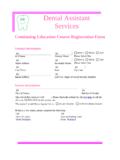Transcription of IPS e.max CAD EnglishRM - ROE Dental Laboratory
1 IPS CAD Scientific Documentation Scientific Documentation IPS CAD Page 2 of 16 Table of Contents 1. Overview of IPS range of IPS 2. Technical 3. Material science Physical 4. In vitro Flexural strength of CAD/CAM-manufactured Fracture strength of inlay bridges fabricated with CAD/CAM Fracture strength of three-unit bridge Fracture strength of posterior crowns fabricated with CAD/CAM Fracture strength of thin, CAD/CAM-manufactured crown 5. External clinical University of University of Boston University of 6. Chemical In vitro Sensitization, 7. Scientific Documentation IPS CAD Page 3 of 16 1. Introduction Overview of IPS range of products IPS is an all-ceramic system that consists of the following five components: IPS Press (lithium disilicate glass-ceramic ingot for the press technique) IPS ZirPress (fluorapatite glass-ceramic ingot for the press-on technique) IPS CAD (lithium disilicate glass-ceramic block for the CAD/CAM technique) IPS ZirCAD (zirconium oxide block for the CAD/CAM technique) IPS Ceram (fluorapatite veneering ceramic) Scientific Documentation IPS CAD Page 4 of 16 IPS CAD Material / Manufacture IPS CAD is a lithium disilicate glass-ceramic (Fig.)
2 1) for CAD/CAM applications. The blocks are produced by massive casting (transparent glass ingots, Fig. 2). A continuous manufacturing process based on glass technology (pressure casting procedure) is utilized in the manufacture of the blocks. This new technology uses optimized processing parameters, which prevent the formation of defects (pores, accumulation of pigments, etc) in the bulk of the ingot. Partial crystallization ensures that the blocks can be processed in a crystalline intermediate phase, which enables fast machining with CAD/CAM systems (blue, translucent state; Fig. 3). The partial crystallization process leads to a formation of lithium metasilicate crystals Li2 SiO3, which are responsible for the material's good processing properties, relatively high strength and good edge stability.
3 Following the milling procedure, the restorations are tempered and thus reach the fully crystallized state. In the course of this process, lithium disilicate crystals (Li2Si2O5) are formed, which impart the ceramic object with the desired high strength. lithiummetasilicatelithiumorthosilicatel ithiumdisilicatelithiummetasilicatelithi umorthosilicatelithiumdisilicate Fig. 1: Materials system SiO2-Li2O 1 (Schmelze = melt) Fig. 2: Glass ingot Fig. 3: Partially crystallized block Scientific Documentation IPS CAD Page 5 of 16 Coloration The colour of glasses is produced by colouring ions. The polyvalent colouring elements show a different oxidation state in the crystalline intermediate phase than in the fully crystallized state. Thus in the partially crystallized state, the blocks exhibit a blue color (Figs.)
4 3 + 4). The material acquires the desired tooth color and opacity during a kind of re-crystallization process, in the course of which lithium metasilicate is transformed into lithium disilicate, and subsequent cooling for a defined period of time (Fig. 5). Fig. 4: Bridge framework in the partially crystallized state Fig. 5: Bridge framework in the final state (fully crystallized) Microstructure Partially crystallized IPS CAD (Fig. 6): The microstructure consists of 40% lithium metasilicate crystals (Li2 SiO3 ), which are embedded in a glassy phase. The grain size of the platelet-shaped crystals is in the range of to m. The etched-out areas represent the lithium metasilicate crystals. Fig. 6: Partially crystallized IPS CAD (SEM, etched with for 10 sec.) End-crystallized IPS CAD (Fig.
5 7): (tempered at 850 C ) The microstructure consists of approx. 70% fine-grain lithium disilicate crystals (Li2Si2O5), which are embedded in a glassy matrix. By etching with hydrofluoric acid vapour, the glassy phase is dissolved and the lithium disilicate crystals become visible. Fig. 7: Fully crystallized IPS CAD (SEM, etched with HF vapour for 30 sec.) Scientific Documentation IPS CAD Page 6 of 16 2. Technical Data IPS CAD Ceramic blocks for the CAD/CAM technique Standard Composition: (in wt %) SiO2 Li2O K2O P2O5 ZrO2 ZnO Other and colouring oxides Physical properties: In compliance with: ISO 6872 Dental ceramic ISO 9693 Metal-ceramic Dental restorative systems Flexural strength (biaxial) 360 60 MPa Chemical solubility 40 10 g/cm2 Coefficient of thermal expansion (100 400 C) 10-6K-1 Coefficient of thermal expansion (100 500 C) 10-6K-1 Scientific Documentation IPS CAD Page 7 of 16 3.
6 Material science investigations Physical properties Table 1: Physical properties (Ivoclar Vivadent, Schaan, 2005) Physical properties Partially crystallized state Fully crystallized state Biaxial strength (ISO 6872) 130 30 MPa 360 60 MPa Fracture toughness (SEVNB) MPa m MPa m Vickers hardness 5400 100 MPa 5800 100 MPa Modulus of elasticity 95 5 GPa CTE (100-500 C) 10-6/K-1 Density g/cm3 Linear shrinkage during the tempering process Chemical solubility 100 160 g/cm2 30 50 g/cm2 Scientific Documentation IPS CAD Page 8 of 16 4. In vitro investigations Flexural strength of CAD/CAM-manufactured rods The test rods (3x4x13mm; n=15 per material) were fabricated using CAD/CAM technology (Cerec). Subsequently, their flexural strength was determined with a universal testing machine using a three-point bend test.
7 050100150200250300Mk IIProCADG lass-ceramic (ZrO2-reinforced)IPS strength [MPa] Fig. 8: Flexural strength of test specimens fabricated using the CAD/CAM technique (Bindl et al, 2003)2 The flexural strength of IPS CAD was significantly higher than that of all other materials tested. Fracture strength of inlay bridges fabricated with CAD/CAM technology Inlay bridges made with CAD/CAM systems were placed on test models without the prior application of cement. The fracture load was determined using a universal testing machine (15 specimens per material). The load was applied to the pontic. After the test, the test models were checked for possible damages. If no damages were visible, they were used in further tests. Scientific Documentation IPS CAD Page 9 of 16 0400800120016002000Mk IIProCADG lass-ceramic (ZrO2-reinforced)IPS CADC omposite1 Composite2 Fracture load [N] Fig.
8 9: Fracture strength of inlay bridges fabricated with CAD/CAM technology (Bindl et al, 2003)2 The fracture strength of IPS CAD and Composite 2 was significantly higher than that of all other materials tested. Fracture strength of three-unit bridge frameworks A Cerec milling unit was used to mill the IPS CAD frameworks. Subsequently, they were immersed in water for 24 hours. Then the inner surfaces were subjected to different treatments. The fracture load was determined statically using a universal testing machine. The load was applied to the pontic. 0200400600800100012001400 IPS CADgrinded inside IPS CADetched insideIPS CADsand-blasted insideIPS Pressetched inside Fracture load [N] Fig. 10: Fracture strength of three-unit bridge frameworks subjected to different kinds of pre-treatment (Schr der/ Spiegel 2005) 3 IPS CAD bridge frameworks are significantly weakened by sandblasting.
9 Scientific Documentation IPS CAD Page 10 of 16 Fracture strength of posterior crowns fabricated with CAD/CAM systems Thirty crowns per material were milled with Cerec. Fifteen crowns of each material were conventionally cemented on dies, while the other 15 were adhesively luted. The fracture load was determined using a universal testing machine. 050010001500200025003000 IPS Load [N]zinc-phosphate cementedadhesively cemented Fig. 11: Load to fracture of CAD/ CAM-manufactured posterior crowns cemented using different cementation procedures (Bindl et al. 2005) 4 In conjunction with the conventional cementation technique, IPS CAD achieved significantly higher values than all the other materials. In conjunction with the adhesive luting technique, no significant difference was found between the different materials tested.
10 IPS CAD shows significantly higher values when used in conjunction with adhesive luting materials than when used with conventional cements. Fracture strength of thin, CAD/CAM-manufactured crown copings Posterior crown copings with a thickness of mm were milled with the Cerec milling unit. Three different types of material were used: - Lithium disilicate glass-ceramic (IPS CAD) - Infiltrated ceramics (In-Ceram Zirconia) - Yttrium-stabilized zirconium oxide (In-Ceram YZ cubes) Thirty crowns per material were milled with Cerec. Fifteen crowns of each material were conventionally cemented on dies, while the other 15 were adhesively luted. The fracture load was determined using a universal testing machine. Scientific Documentation IPS CAD Page 11 of 16 05001000150020002500 IPS CADIn-Ceram ZirconiaIn-Ceram YZCubesFracture load [N]zinc-phosphate cementedadhesively cemented Fig.







